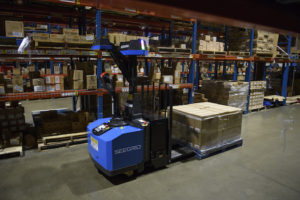
Automation in the supply chain increases efficiency, reduces costs, and decreases errors. Today, Seegrid, which makes connected self-driving vehicles for materials handling, has announced the GP8 Series 6 self-driving pallet truck. The truck is fully automated to pick up, move, and drop off materials without human intervention.
The trucks can run without human intervention on a 24/7 basis. “The biggest feature request from our customer base in manufacturing, distribution, and fulfillment is hands-free load exchange,” Jeff Christensen, vice president of product with Seegrid told EBN. “To get the most out of self-driving technology, they want to automate the process from end to end. The hands-free element increases the economic value.”
From a Lean Manufacturing perspective, horizontal movement of materials is considered a non-value added activity, and should be automated if possible. The new truck handles horizontal movement of pallets of equipment, products, and other materials.
“The GP8 Series 6 closes the automation loop by providing an end-to-end solution, removing the need for human assistance to complete tasks,” said Christensen. “In manufacturing and e-commerce environments, every human touch is costly and unpredictable. As we help our customers develop smart factories of the future, safety, efficiency, and operating costs will continue to be the driving forces behind the adoption of automation. Loading and unloading pallets independently creates safer working conditions, allows for more consistent throughput, and produces a rapid return on investment for our customers.”
The GP8 does not follow paths created by wires, lasers, magnetics or tape. Instead, it uses cameras as sensors to allow the machine to both move independently and to adapt to changes in the environment, Christensen said. Users can train the vehicle to do desired tasks using a teach and repeat model. In addition, the vehicles can be dispatched through other distribution or warehouse systems. “There’s no previous automation experience required,” said Christensen. “Customers can take an incremental path toward automation by wading into the shallow end on their end and working toward more sophisticated usage.”
In the end, automating materials handling provides measurable value. “Compared to other capital investments, the return on investment it is right in line or more aggressive than other technologies that have been around and add flexibility,” said Christensen. In most cases, organizations can achieve payback in eighteen months, and in some cases less than a year.
Many organizations leverage the technology to increase safety within the organization—and report that it is the main driver for them to use automated materials handling, Christensen said. Further, instead of reducing headcount, employees can be moved to tasks with higher value to do things they couldn’t do before. “It’s better for human beings anyway, because they can spend their time on creativity and decision making,” Christiensen said. “They become the ones that maintain and operate the technology as well.” In addition, the company can lower manufacturing handling costs, he added.
Read more: New Seegrid Offering Puts Self-Driving Vehicles in the Supply Chain